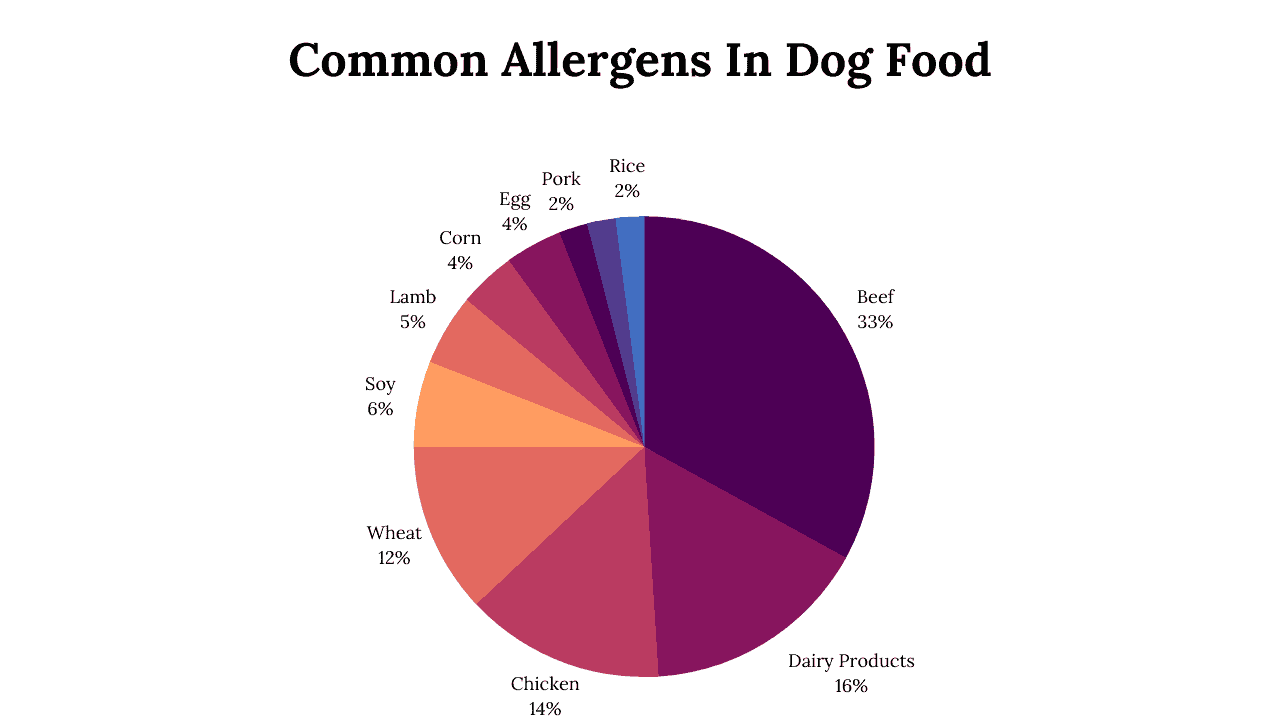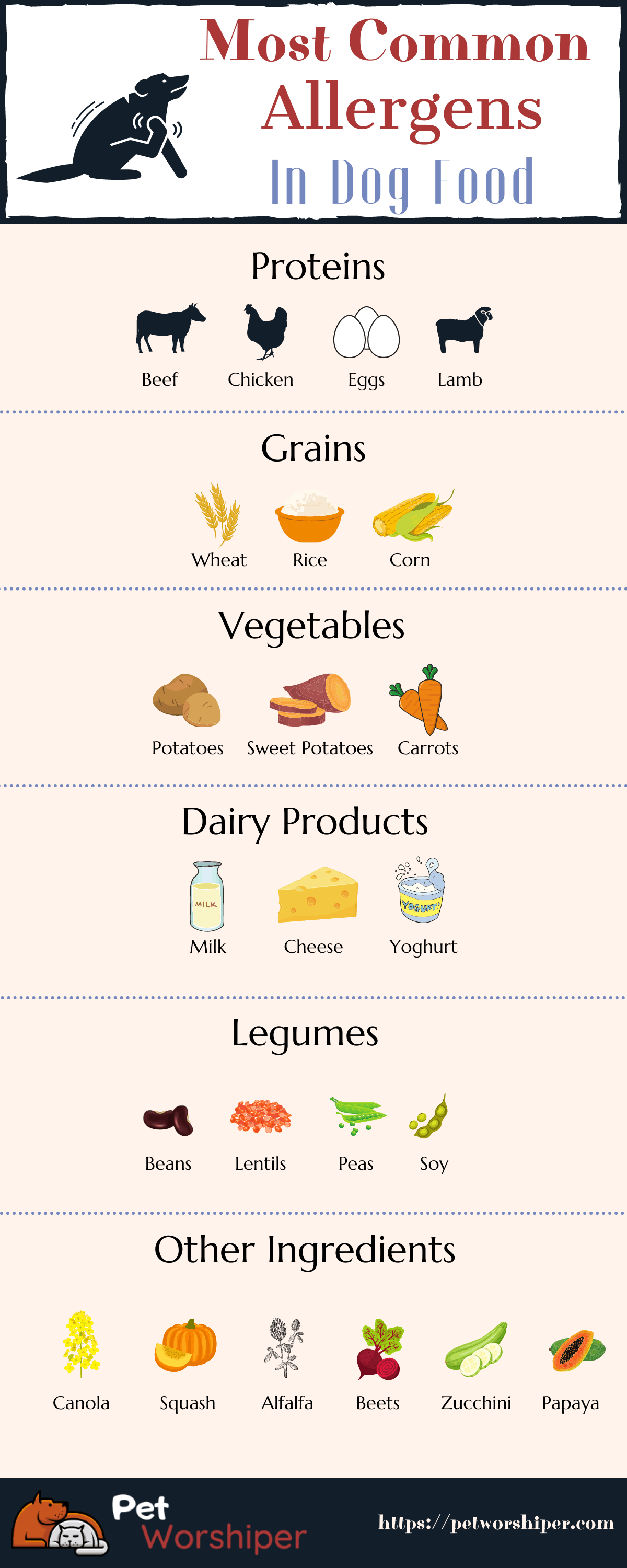
Itching, excessive scratching, ear and skin infections, poor coat quality. If you experience these on your pooch, you should be familiar with dog food allergies. This is a fairly common condition that can potentially threaten any dog.
From my article, you can learn about the causes of these dog allergies, their treatments, the most common allergens, and prevention and diagnosis methods, among other things. I hope my article will help you get answers to some important questions.
What is Food Allergy
Food allergy is a certain immune response that is usually triggered by some protein. So if the dog food contains the protein in question, then consuming it will cause allergic reactions in the dog.
Although allergies can be linked to proteins, this does not mean that they can only be caused by meat and other animal protein sources. This is because different carbohydrate sources, fruits, and vegetables also have protein content, so they can also be potential allergens.
And how exactly does the allergic reaction occur?
The food eaten by the pet gets into the stomach, where the stomach acid and the enzymes in it break down the proteins into smaller structures.
The partially digested food then enters the small intestine, where the protein structures become amino acids. Amino acids can be absorbed in the body by cells called enterocytes.
This is the normal process when everything is done as intended. However, it happens that proteins fail to break down and get into the intestines in full. This triggers immune reactions of varying severity in the body.
So you can see that total proteins mustn’t be absorbed through the intestinal tract. The integrity of the mucosal barrier may provide this ability.
The mucosal barrier (also known as gut lining) consists of structural and immune system elements. The purpose of the former is to impede the absorption of large proteins physically. And the latter is responsible for recognizing harmful elements in the digestive system.
Thus, the condition of enterocytes, efficient protein digestion and immune cells’ presence are jointly responsible for the gastrointestinal tract’s health.
Intestinal immune cells (also known as IgA cells) are located in the intestinal contents or in the intestinal wall.
Their purpose is to prevent whole proteins and enterocytes from coming into contact with each other. If this process goes well, the proteins will be returned to the intestinal contents for further digestion. When proteins are small enough or digested into amino acids, IgA cells allow them to be absorbed.
Malfunctioning enterocytes can allow undecomposed total proteins into the body. A lymphoid tissue known as GALT can block the immune response. This happens in many cases, but if not, we can talk about an allergic reaction.
In general, each subsequent immune response is stronger than the previous one. Therefore, it is important to eliminate the allergen from your dog’s diet.
When eating problematic food, immune cells produce a substance called hertamine, which can cause diarrhea and various skin problems (itching, irritation, inflammation).

Difference between Dog Food Allergies vs. Dog Food Intolerances
Well, I have detailed above what exactly a food allergy is and what it involves. When a problematic food is eaten, immune reactions develop in the dog. As a result, certain compounds (histamine, hertamine) are produced in the body, which practically causes allergic reactions.
Symptoms of food intolerances or food sensitivities may be similar, but no immune response is elicited. A common example is lactose intolerance, in which the body does not produce the lactase enzyme needed to digest lactose. Thus, it can cause stomach pain, diarrhea, and other digestive problems.
Otherwise, intolerances are more common than allergies in dogs. It is important that you do not want to determine the exact disease based on your dog’s symptoms but consult your vet.

Finding the best diet for your dog is not easy. You have to consider several aspects, e.g., activity, breed, age, health condition, etc. If you want to make the best decision possible, check out my comprehensive guide on how to choose the best dog food.
Most Common allergens in dog foods
As I mentioned earlier, almost anything can cause an allergic reaction that has protein content. Thus, not only meats but also vegetables, fruits, or grains. BMC Veterinary Research has identified some common elements that cause allergic reactions in dogs. I will share these as a percentage with you. Later you will find an infographic where you can find all the possible allergens.

Some facts can be observed, and I should definitely mention them. First, you can see that the most common sources of protein occur as allergens.
As you read in a previous section, this is no wonder; exposure to an allergic reaction is necessary. Since beef and chicken are the most common animal protein sources in dog foods, this also explains why these allergens, are more common than, for example, fish, or turkey.
Carbohydrate sources are generally less of a hazard, but this is not negligible either. High-protein grains (such as corn or wheat) are common allergens.
Starches such as potato starch alone do not cause allergies. However, whole potatoes can be a potential allergen due to their protein content.
Unfortunately, it also happens that if a dog is allergic to more than one food ingredient. With a proper allergy test, you can easily find out.
However, you should be aware that the research mentioned above and previous research is already many years old and may not necessarily be considered relevant and up to date.
The processing and preparation of dog foods are constantly changing, and more and more allergies may appear. Therefore, further research would be needed.
I compiled a comprehensive infographic of possible food allergens:

Symptoms of dog food allergy
The dog food allergy symptoms can be varied. From simple sneezing to skin problems to indigestion and behavioral disorders, anything can happen. Complicating the situation is that dogs with food allergies often also have environmental allergies. The symptoms of the two types of allergies can be very similar.
Below is a detailed list of signs and symptoms of dog food allergy:
- Itching (skin and/or paws)
- Sneezing
- Hot spots
- Rashes
- Scaly, oily, or pigmented skin
- Leathery skin texture
- Excessive discharge in the eyes
- Red eyes
- Hair loss
- Ear, yeast, or bacterial infections
Itching most commonly occurs on the ears or paws. But itching of the inner thigh, belly, eyes, or front leg is also common.
Observations have shown that food allergies are less likely to cause digestive and intestinal symptoms. Of course, these also happen. Examples include diarrhea, constipation, vomiting, and abdominal pain.
There are even rarer allergy symptoms such as nasal discharge, difficulty breathing, weight loss, seizures, and urinary tract infections.
As I mentioned, behavioral problems can also occur as symptoms. These are also rare, and most of them are related to the discomfort associated with physical symptoms. Such behavioral symptoms include:
- Frequent scratching
- Shaking or scratching ears
- Paws or tail biting
- Food refusing
- Restlessness
- Depression
What are the effects of dog food allergies?
If you suspect a food allergy with your dog, the best thing to do as a first step is to consult your veterinarian. This condition needs to be treated.
Untreated dog food allergies can cause additional health problems that can seriously impact your pooch’s quality of life. These include severe skin infections, additional allergies and symptoms, and behavioral changes.
Dog food allergies are not fatal, but if you want to make your dog feel better, making a diagnosis and proper treatment is critical. You will get some help with these below.

How to tell if a dog has a food allergy?
Dog food allergy, environmental allergy, but even intolerances or food sensitivities can have similar symptoms. In general, it can be said that intolerances and environmental or flea allergies are much more common than dog food allergies.
Be sure to ask your vet for help, who will get closer to the answer with blood tests or intradermal allergy testing. However, there are signs and conditions that most likely indicate that your dog has a food allergy.
One such example is the age of your pet. It is worth noting that environmental allergies rarely occur in dogs less than 1 year of age.
It can also be a telltale sign if the allergic reaction is, so to speak, permanent, i.e., non-seasonal, or tied to an area or country.
Dog food allergies can also be linked to skin problems and gastrointestinal symptoms on your pooch. But if he doesn’t respond to steroid treatments, it could also be a sign of a dog food allergy.
Elimination method
This method, although lengthy, is very effective and is based on a simple principle.
If you suspect your dog’s food, choose another product. Limited ingredient diets are best. They have a single source of protein (for example turkey) and carbohydrates and few sources of fruits, vegetables, and other nutrients.
It’s best if the animal protein source is something your dog hasn’t tried before. A good idea might be lamb, fish, or so-called novel animal proteins like duck, venison, or kangaroo.
Of course, the new food should not contain any common food allergens, fillers, or artificial additives. Also, do not give your dog human food, dog treats, table scraps, snacks, or the like.
This new diet should last for at least eight weeks. If the diet is successful and the symptoms are gone, you are still not ready.
You need to know exactly that the previous dog food was responsible for your dog’s condition, give your dog back the previous dog food. If allergic reactions reappear, it can be confirmed with absolute certainty that the previous diet caused the problems.
You should not miss this last step. I know you don’t want to have unpleasant symptoms in your pet again, but this is the only way to effectively avoid the various tests and exclude problematic ingredients from your dog’s diet with sufficient confidence.
Related Dog Nutrition Guides:
Dog food allergy tests
In addition to the elimination method, there are also various tests. These are less effective, but you may want to try them.
Blood tests are constantly being developed, and more recent ones are increasingly detecting possible dog food allergies. However, it is still better to choose the elimination method instead. I think it is conceivable that there will be accurate blood tests in the future, but that is not the case at the moment, unfortunately.
Another type of test is patch tests. These work by mixing a certain protein with Vaseline and gluing it to the skin for 2-3 days. If skin allergies (e.g., rash, erythema) occur, the test is considered positive. Patch tests are generally more effective than blood tests. However, they are also much more cumbersome as you have to be careful that the patch stays on your pup for days.
Are there breeds that are more prone to food allergies?
This is an interesting question. After all, it would be important to know if our chosen dog will have any future problems.
The answer, in short, is no. That is, there are no dog breeds that are more prone to food allergies. In theory, all dogs can develop this disease.
What we do know, however, is that the condition has a high chance of being inherited. So our puppy is likely to have a dog food allergy if one of his parents also had an allergy.
So genes and inheritance have a role to play in this, but so far, there is no evidence that it all has to do with dog breeds. Gender and age are also not important, as males, females, puppies, adults, and seniors alike can develop a dog food allergy.
Some breeders will not agree with this, as their experience shows otherwise. However, I think the reason for this is the heritability factor rather than the breed tendency.

Treating food allergies in dogs
As I mentioned in my article, the most important step is to talk to your vet. He will probably be proposing an elimination diet first. Also, there are other tactics you can try. I will detail these below.
Medications
Medications have the ability to treat symptoms, although they do not necessarily provide a long-term solution. Antihistamines (e.g., Benadryl) treat unpleasant itching and are considered safe. Of course, only get these with the permission of your vet.
Various anti-itch shampoos, creams, and ointments can also be effective. But your vet-ed permission is required for these as well.
Antifungals and various antibiotics are effective when we want to treat secondary infections and other symptoms. However, these alone do not solve the problem.
In most cases, steroids and other anti-inflammatory drugs do not affect dog food allergies.
Homemade diets
It’s easy to understand why homemade dog foods can be a good solution for treating allergies. This is because they act as an elimination diet.
The pet owners can decide which source of protein, carbohydrate, and fat to use. This makes it easy to filter out problematic ingredients.
But it’s essential to know that good homemade dog food isn’t easy to make. You need to research the topic, as these diets can lack many important nutrients if not properly formulated.
Vegan diets
I think this opportunity should be the last, but I definitely wanted to mention it. Sometimes a dog is allergic to several types of meat. While there will probably be animal resources you haven’t tried yet, you may want to consider a vegan diet.
It can be homemade or commercial. Whichever one you choose, you should pay close attention. For homemade diets, ask an animal nutritionist to help.
I don’t have excellent experience with commercial vegan dog foods. Plenty of such products lack important nutrients.
Dog food allergy prevention
The thing is, there aren’t really any specific ways to prevent dog food allergies. However, there are steps we can take to help our dog overcome allergies.
One of the most important steps is to provide our canines with a healthy, complete, and balanced diet. This keeps the intestinal mucosa in good condition and helps fight allergies.
Some experts say gastroenteritis may also cause food allergies in the future. This is because this disease greatly destroys the condition of the intestines.
And what can cause gastroenteritis? Well, the reasons can be many, but one of the most common is when the dog eats something he shouldn’t. For example, manure, feces, garbage, or dead animals. Try to prevent this as soon as possible.
If trouble has occurred and your dog has eaten something unhealthy, consult your vet and provide him with a low protein diet. Diarrhea is a natural reaction from the body, so you don’t have to be scared or prevent it with some home remedy. You should do this for proper gut health.
If you give your dog home-cooked dog food or raw food, you can make it easier for him to digest proteins. The easiest way to do this is with a grinder, which will cut the meat into small pieces. Digestibility is a key issue in the development of food allergies. Commercial dog foods generally do not require further grinding.
Choosing limited ingredient dog foods with a single protein source can also be a good idea. Usually, these prove to be the best dog foods for allergies. On the one hand, low protein sources are less likely to trigger allergies. On the other hand, if your dog shows signs of a particular product, you will know which animal meat you should avoid next.

Frequently asked questions
I am sure you still have questions about this topic. Below you can read the most common ones.
How long does it take for food allergy to show up in dogs?
The onset of dog food allergy symptoms depends on the type of symptoms and the individual differences in the dogs. However, it can be said that skin problems (e.g., hives) usually appear within 24 hours after consuming the triggering food.
Can dogs suddenly become allergic to his food?
Generally, long-term exposure is required for the onset of allergic symptoms. Therefore, it may happen that consuming a certain food for a while does not cause a problem in dogs, and this suddenly changes.
What are the symptoms of chicken allergy in dogs?
All food allergies have the same potential symptoms. These include itchy skin, ear infections, gas formation, hives, diarrhea, excessive licking, and so on.
Will Benadryl help a dog with food allergies?
Yes, Benadryl is an effective medication for the treatment of not very severe allergies.
Summary
Dog food allergy is not a fatal condition, but it is worth dealing with. The most important thing is to consult your vet. It would help if you established the exact diagnosis, the trigger, and the treatment.
This is a lengthy process in many cases, as the elimination diet should last for a minimum of 8 weeks. But you have to be patient and consistent. This is the only way to protect your dog. The most important thing is to provide him with a healthy and nutritious diet in all respects.

